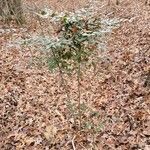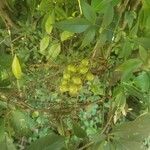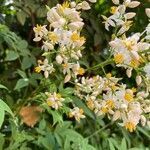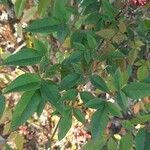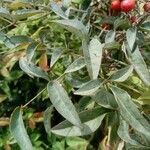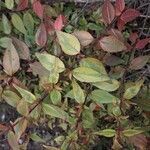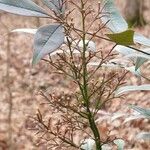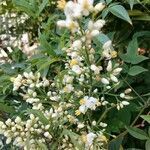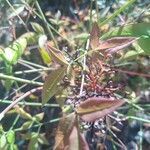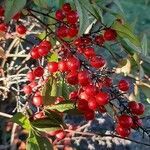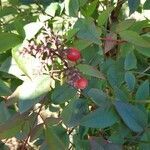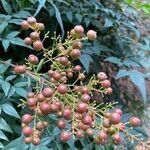Shrubs, evergreen, erect, to 3 m tall, glabrous, few branched. Branchlets reddish when young. Leaves 30-50 cm; leaflets nearly sessile; blades elliptic or elliptic-lanceolate, 2-10 × 0.5-2 cm, weakly leathery, glabrous, base cuneate, apex acuminate. Inflorescences erect, 20-35 cm. Flowers cream or white. Sepals ovate-triangular or ovate-oblong, 1-4 mm. Petals oblong, ca. 4.2 × 2.5 mm, apex obtuse. Stamens ca. 3.5 mm; anther connective prolonged. Ovary locules 1; ovules 1-3. Carpopodium 4-8 mm. Berry red or purplish, 6-8 mm in diam. Seeds grayish or brownish, oblate-spheroidal. Fl. Mar-Jun, fr. May-Nov. 2n = 20*.
Stems erect. Wood and pith bright yellow. Leaves frequently reddish tinged, 5-10 dm; petioles basally enlarged and clasping. Leaflets 9-81, nearly sessile, leaflet blades 4-11 1.5-3 cm, base cuneate, apex acuminate. Inflorescences with hundreds of flowers, 1-2 dm. Flowers fragrant, pedicellate; perianth segments imbricate, weakly 2-4-seriate. Berries 6-9 mm. Seeds mostly 2. 2 n = 20.
A thick stemmed shrub. It keeps growing from year to year. It grows 1.2-1.8 m tall and spreads 90-150 cm wide. The stems are unbranched. They carry large leaves consisting of many narrow segments. The leaves are purplish red when young. Plants are separately male or female. The flowers are white and starry. They have long yellow anthers. The fruit are red berries.
